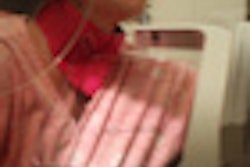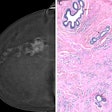Thyroid collars are not need for mammograms, according to new guidelines on minimizing radiation dose issued on June 13 by the American Thyroid Association (ATA). However, the association advised a number of other steps to minimize unnecessary exposure to radiation from medical and dental imaging procedures, such as the use of collars for dental x-rays.
With more than 56,000 cases of thyroid cancer likely to be diagnosed in the U.S. in 2012, the incidence of thyroid cancer is increasing faster than any other cancer, the ATA noted. Although it is unlikely that radiation exposure is the predominant contributor to this trend, an increase in the use of diagnostic x-rays, particularly CT, is widespread and necessitates the protection of the thyroid gland when possible to diminish thyroid cancer risk.
In a 2005 brochure about thyroid cancer, the ATA stated that "routine x-ray exposure (e.g., dental x-rays, chest x-rays, and mammograms) does not cause thyroid cancer." While scientific knowledge at the time supported this language for the one-time use of the modalities cited, the statement did not take into account repeated exposure through diagnostic x-rays over a patient's lifetime or the increasing use of alternative procedures, such as CT, in which doses to the thyroid are generally much larger, according to the association.
This prompted the ATA in 2011 to initiate a review of radiation as a cause of thyroid cancer, with the aim of establishing a policy that would state its view on how the exposure of the thyroid to radiation should be minimized.
The ATA's chief conclusions and recommendations are as follows:
- The risk of thyroid cancer arising from radiation exposure strongly depends on age at exposure. It is only recently that a thyroid cancer risk for exposure after age 15 has been observed. This risk is low, but not absent.
- For the purposes of public health planning, most experts and organizations assume that the risks for cancer, including thyroid cancer, are reduced proportionately with the dose.
- The necessity of all diagnostic x-rays should be evaluated before they are performed. This must include the potential risks as well as the potential benefits to the patient. This must also include a consideration of the alternative methods for obtaining the same or related clinical information.
- Thyroid-protective collars should be used for all dental x-rays when they do not interfere with the examination. Thyroid-protective collars are not needed for screening mammograms.
- The patient or the patient's decision maker should be made aware of the potential risks and benefits of radiation in a manner that is understandable to them.
- Clinicians should be adequately informed about the potential risks of radiation and the general principles of radiation dosimetry, especially as they relate to children and to the thyroid.
Whether women should wear thyroid collars became a source of controversy in 2011, after episodes of the "Dr. Oz Show" in which television personality Dr. Mehmet Oz advised women to wear thyroid shields when undergoing mammograms. Many breast imaging experts disagreed with Dr. Oz's statements.



















